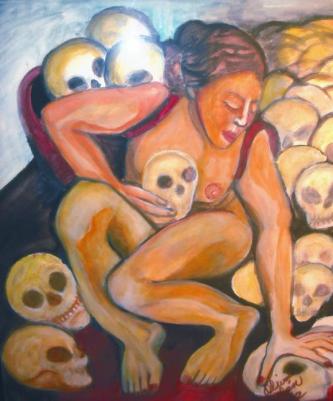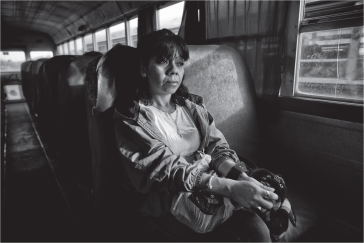
This painting by Ruth Ollivar Millan accompanies a poem conveying the feelings of heartbreak, loss and powerlessness that are experienced by the families of femicide victims. “Don’t forget me!” the poem exclaims, a call for remembrance of the murdered women, as well as a call to justice for those who commit these atrocities.
Maquiladoras, Misogyny, and Migration: Exploring Femicide in Ciudad Juárez
Emily Bruce, Chelsea Fink & Denise Lopez
The women of Ciudad Juárez, Mexico have been facing the perpetual fear of gender driven violence for over twenty years. While the total number of victims and individual stories may vary, there is one thing that remains clear: there is still a critical situation occurring in Juárez that continues to affect women and their families, yet there remains no definitive solution in place. This dossier is examining the multiple components that contribute to the proliferation of femicide, as well as the actions being taken to curb it. A spike in female migration to Mexico’s borders, stemming from the North American Free Trade Agreement (NAFTA) implemented in 1994, inflamed misogynistic sentiments among many men who saw the transition of women from the home to the workplace as threatening and has contributed to an unprecedented social pathology in which a misogynistic chain of homicides and impunity [1] have occurred. This increased sense of social imbalance proceeding from disrupted social norms in the wake of NAFTA, combined with deep-seated apathy among government authorities regarding crimes against women, and gender discrimination, are the main determinants this dossier will be examining.
The extraordinarily high rate of femicide in Ciudad Juárez, as many as 6 women a day, according to studies conducted by 43 separate groups forming the National Citizen Femicide Observatory Mexico[2] as of January 2015, reveals that, despite over 20 years of struggle, the war on femicide is not nearly over. The complex series of interrelated factors that first became visible in 1993 spurred international interest, yet despite the efforts of NGOs such as Justicia Para Nuestras Hijas and Nuestras Hijas de Regreso a Casa A.C., who continue to persist in the battle against femicide, the government, while adopting new laws, has had less progress in implementing them than human rights activists and families of victims demand. Independent actors, such as lawyer Imelda Marrufo Nava[3] have also stepped in, supplying legal support through Red Mesa de Mujeres, and, with backing from The Global Fund for Women, her network of 10 different organizations work together in an effort to assist families of victims, while calling on the state to accept more responsibility and acknowledge femicide as a human rights violation. Recent trials held by the PPT in Ciudad Juárez reflect the sheer volume of complaints Mexican citizens have against the government regarding human rights violations[4].

This picture depicts women’s common return home after working in the maquiladoras, by bus with no protection. Here, Josefina Campa is pictured leaving her job after a day of working in the maquiladoras in Ciudad Juarez. Photographer: Katie Orlinsky.
While awareness is being raised and steps are being taken to implement new safeguards to protect women, such as the General Law of Access for Women to a Life Free from Violence (GLAWLFV), these have yet to be fully actualized and the State continues to neglect its duty to protect women and address the sources of violence against them.
Femicide rates have remained steady in the past few years with relatively little being done by the government to prevent these crimes or punish the perpetrators. While OSAC declares that overall homicides have declined in Juárez[5], UN officials cite Mexico as among the 20 most dangerous countries for women[6] and according to the Global Fund for Women as of April 2015, “600 women have been killed and at least 3,000 are missing”[7]. Despite efforts Ciudad Juárez still finds itself at the center of a violent, misogynist cultural crossroads.
Continue reading the Dossier MAQUILADORAS, MISOGYNY AND MIGRATION- EXPLORING FEMICIDE IN CIUDAD JUÁREZ for more information.

This image conveys the horrifying yet unavoidable reality of femicide: disturbing, violent and uncomfortable. The issue of femicide is all of these things, as gender driven violence continues to plague Ciudad Juárez lives are lost and families are destroyed. Women are targeted, attacked and brutalized daily, leaving a trail of devastation in the wake of these crimes.
[1] Martinez-Ortiz, Maria Theresa, “Making Community in Juárez: A Cultural Analysis Making Community in Juarez: A Cultural Analysis of Feminine Expressions of Resistance in Literature and Film” p. 77-95 Asociacion Internacional de Literatura y Cultura Femenina Hispanica
[2] Matloff, Judith. “Six Women Murdered Each Day as Femicide in Mexico Nears a Pandemic.” Al Jazeera America. 4 Jan. 2015. Web. 5 May 2015
[3] Staff. “A Lawyer Shines Light on Systemic Femicides in Ciudad Juarez.” Cctv-America.com. Cctv America, n.d. Web.
[4] Coll, Tatiana. “The People’s Permanent Tribunal in Mexico: Taking on Structural Violence.”
[5] Staff. “Mexico 2015 Crime and Safety Report: Ciudad Juarez.” Osac.gov. Bureau of Diplomatic Security, U.S. Department of State., 4 Mar. 2015. Web. 15 May 2015.
[6] Matloff, “Six Women Murdered Each Day as Femicide in Mexico Nears a Pandemic.”
[7]Staff. “Global Fund for Women.” Global Fund for Women. N.p., n.d. Web. 29 May 2015.
Pingback: STOP Femicide. Mass Demos In Argentina vs Male Violence | The Free
Thank you for using my painting to promote your important and necessary work.
LikeLiked by 1 person